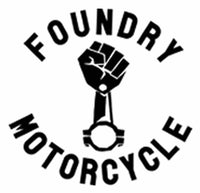
FEW CUSTOM MOTORCYCLES have the cachet of the legendary Triton. The mash-up of a Norton featherbed frame and Triumph twin motor has become a demigod icon of the café racer movement.
As we all know, back in the 60s the idea was to combine the best chassis with the best motor. But half a century later, you can buy showroom machines that’ll run rings around most Tritons. And for a fraction of what it would cost to build one.

So we were surprised to learn that the owner of this beautifully crafted, English-built Triton has a well-stocked garage of modern bikes. It currently houses a Honda RC30 and RC45, a Ducati Panigale R and Desmosedici RR, and a Triumph T120—all of which see regular use.
Even so, he just had to have a Triton. So he reached out to Tom Simpson and Alex Chesson of Foundry Motorcycle, based near the small cathedral city of Chichester, West Sussex.

“Our customer David came in brandishing a printout of the Bike EXIF feature on Loaded Gun’s Triton from a few years back,” explains Alex, “which we discussed (favorably) at length.”
“He’d always wanted a Triton, but didn’t really like the ‘traditional’ bikes. So we worked out how to make one that looked a little more modern, whilst retaining the classic essence of the bike. It had to be less ‘cobbled together’ than so many of the traditional machines, and hold its head up in the company of the rest of his collection.”

“We don’t use Photoshop here—just drawings with pens and paper. After a few different ideas were sketched, we had a starting point, and went in search of the suitable donor machine.
“Triton buying can be somewhat of a minefield, with price and condition varying massively, but eventually a usable bike was found.”

The donor they eventually found had a 1963 Triumph T120 Bonneville engine, wedged into a 1961 Norton Dominator Slimline featherbed frame. Tom and Alex’s first job was to finetune the frame—starting with a de-tab.
They wanted sharper lines out of the subframe, so they redesigned it, and added mounts for a new seat unit. They then built new rearset and rear engine mounting plates, so that they could ditch the ugly Converta plates that came with the bike.

The swing arm was scalloped to fit a 110 wide rear tire, and a new side stand was built.
The brief called for a disc brake up front, so the guys swapped the Norton forks for a set of Triumph T140 units. That meant fitting new yokes—so they reached out to Danny at Fastec Custom Racing, who whipped up a set to Foundry’s design. The top yoke includes an integrated housing, to hold a Motogadget Chronoclassic tacho.

A new front wheel was built around the T140’s hub and brake setup, and a new rear on the stock Norton hub. Both feature Morad alloy rims and Avon Cobra tires, with a 19” up front and an 18” out back. The rear end’s held up by a new set of YSS shocks.
Next up was the aluminum bodywork—with the seat unit being the toughest bit.

“We wanted the oil tank to be part of the seat and cowl combination,” says Alex, “to help keep the middle of the bike as clean as possible. We had other ideas there, which didn’t include the original fiberglass oil tank and Tetley tea bag tin battery box.”
The final execution is minimal and elegant. A bolted-in undertray keeps the tail tidy, with a proprietary Foundry LED taillight hiding underneath the rear cowl. Follow the plumbing, and you’ll spot a nifty oil cooler mounted lower down in the frame.

“It’s really more about looking good and increasing oil capacity, rather than significantly lowering oil temperature,” says Alex. “And it gave us another opportunity to indulge in one of our favorite processes: sand casting aluminum.”
The cooler was eventually cast using melted down small block Moto Guzzi crankcases. “We’re big Guzzi fans, and the cases were definitely past use.”

Hiding underneath the cooler is an electronics tray, and underneath that, the battery. Everything’s been rewired and hooked up to a Motogadget m.unit, complete with a keyless ignition.
Moving to the motor, Tim and Alex stripped it right down, and rebuilt it with new seals and bearings, plus a Routt 750 big bore kit. Even though the guys were happy with the original Amal carbs, they’re big Dell’Orto fans—so they installed a set of Dell’Orto PH36 pumper carbs.

The stainless steel exhaust system was fabricated in house, right through to the lightly-baffled mufflers, and custom hangers.
Up front, they’ve fitted a 5¾” Bates-style light and adjustable Tarozzi clip-ons. They’re dressed with mini switches, Biltwell grips, Kellermann bar-end turn signals, and Honda CBR600R levers. The rear-set foot controls are also from Tarozzi, and are hooked up with custom brake and gearshift linkages.

The final finishes are as simple as they are delightful. S Jago Design treated the frame to Jaguar Italian Racing Red paint, A M Metal Polishing made the aluminum shine, and Trim Deluxe handled the seat and tank strap.
“We spent countless hours designing and making small (and hidden parts) for this bike,” says Alex. “There are probably large chunks of the build I’ve intentionally erased from memory. But along with our very patient customer, we are very proud of the end result. It rides well, sounds awesome, and looks great—and is incredibly shiny!”

This Triton now shares a garage with some seriously impressive machines. But we know exactly which one we’d pick, come Sunday morning.
Images by Gary Margerum | Words by Wesley Reyneke of BikeEXIF

Liquid error (sections/article-template line 16): Could not find asset snippets/relatedblogs.liquid

Muchas gracias. ?Como puedo iniciar sesion?
nYqhkAtDVdsZfCME
juUrnHmDTGphvbxd
AmYyMDUCZdzFW
NXreUHKjfb